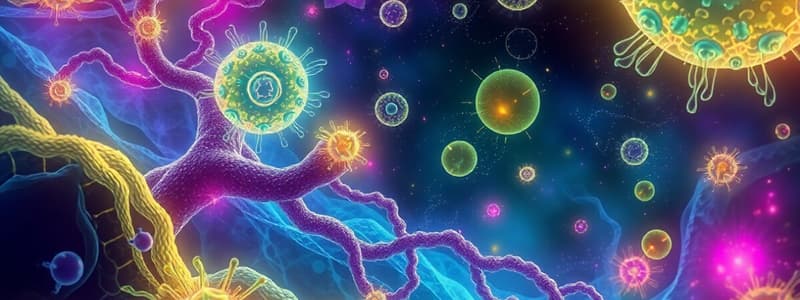Podcast
Questions and Answers
What is the primary function of the objective lenses in a microscope?
What is the primary function of the objective lenses in a microscope?
- To support the microscope structure
- To hold the slides in place
- To illuminate the specimen
- To zoom in on the specimen (correct)
Which part of the microscope is responsible for controlling light intensity to the slide?
Which part of the microscope is responsible for controlling light intensity to the slide?
- Nosepiece
- Diaphragm (correct)
- Illuminator
- Condenser
When should the coarse focus knob be used during microscopy?
When should the coarse focus knob be used during microscopy?
- When switching to higher magnification lenses
- To make fine adjustments to focus
- When first locating the specimen at low power (correct)
- To stabilize the microscope on the surface
Which of the following actions is recommended for safely carrying a microscope?
Which of the following actions is recommended for safely carrying a microscope?
What is the purpose of the stage clips on a microscope?
What is the purpose of the stage clips on a microscope?
Which objective lens would typically provide the lowest magnification?
Which objective lens would typically provide the lowest magnification?
What distinguishes eukaryotic cells from prokaryotic cells?
What distinguishes eukaryotic cells from prokaryotic cells?
What should you do after focusing on a specimen at low power before switching lenses?
What should you do after focusing on a specimen at low power before switching lenses?
Which part of the microscope is designed to help focus light onto the slide?
Which part of the microscope is designed to help focus light onto the slide?
Which of the following statements about tissues is correct?
Which of the following statements about tissues is correct?
Which option accurately describes the relationship between organs and organ systems?
Which option accurately describes the relationship between organs and organ systems?
What does the arm of the microscope connect?
What does the arm of the microscope connect?
Which component of the microscope helps provide stability?
Which component of the microscope helps provide stability?
What is the primary role of DNA in living cells?
What is the primary role of DNA in living cells?
Which of these is NOT a type of tissue?
Which of these is NOT a type of tissue?
Which statement best characterizes organ systems?
Which statement best characterizes organ systems?
What is the function of connective tissue in organs?
What is the function of connective tissue in organs?
Which of the following best defines an organism?
Which of the following best defines an organism?
Which function is primarily performed by muscle tissue?
Which function is primarily performed by muscle tissue?
How do cells within multicellular organisms contribute to overall functioning?
How do cells within multicellular organisms contribute to overall functioning?
What distinguishes eukaryotic cells from prokaryotic cells?
What distinguishes eukaryotic cells from prokaryotic cells?
Which of the following statements correctly describes plant cells?
Which of the following statements correctly describes plant cells?
What is the primary function of the nucleus in a cell?
What is the primary function of the nucleus in a cell?
What type of microscope is ideal for viewing very small structures that cannot be seen with a light microscope?
What type of microscope is ideal for viewing very small structures that cannot be seen with a light microscope?
Which part of the cell acts as a barrier controlling the movement of substances in and out?
Which part of the cell acts as a barrier controlling the movement of substances in and out?
Which organelle is responsible for energy production in both plant and animal cells?
Which organelle is responsible for energy production in both plant and animal cells?
What is the main role of vacuoles within plant cells?
What is the main role of vacuoles within plant cells?
Which of the following does not occur in animal cells?
Which of the following does not occur in animal cells?
What distinguishes fluorescence microscopes from light microscopes?
What distinguishes fluorescence microscopes from light microscopes?
In which type of cell would you find a cell wall?
In which type of cell would you find a cell wall?
Flashcards are hidden until you start studying
Study Notes
Key Terms and Definitions
- Cells: Fundamental units of life; all living organisms are made of cells.
- Eukaryotes: Cells containing a nucleus and organelles; present in humans, animals, and plants.
- Prokaryotes: Simpler cells without a nucleus; exemplified by bacteria.
- DNA: Carries genetic instructions for growth, function, and reproduction of cells.
- Amoeba: A single-celled organism that moves and feeds by changing shape.
Cell Structure and Specialization
- Cells have specific functions; for example, muscle and nerve cells perform distinct roles.
- Tissues are formed by groups of similar cells working together for specific tasks; four main tissue types include epithelial, connective, muscle, and nervous tissues.
- Organs: Composed of various tissue types to perform specific functions (e.g., heart's role in pumping blood).
- Organ Systems: Combinations of multiple organs that work together (e.g., circulatory system includes heart, blood vessels, and blood).
Differences Between Cell Types
- Prokaryotic vs Eukaryotic Cells:
- Prokaryotic: Simpler, smaller, no membrane-bound nucleus.
- Eukaryotic: Complex, larger, contains a true nucleus and membrane-bound organelles.
- Plant vs Animal Cells:
- Plant Cells: Have cell walls, chloroplasts, and large vacuoles.
- Animal Cells: Lack cell walls and chloroplasts, possess smaller vacuoles.
Cell Organelles and Their Functions
- Cell Wall: Provides structural support found only in plant cells.
- Cell Membrane: Thin barrier regulating entry and exit of substances.
- Cytoplasm: Jelly-like substance where cell components are suspended and activities occur.
- Nucleus: Control center storing DNA and coordinating cell functions.
- Mitochondria: Produce energy for cellular activities.
- Chloroplasts: Present in plant cells, facilitate photosynthesis.
- Vacuole: Storage compartment; larger in plant cells, smaller in animal cells.
Types of Microscopes
- Fluorescence Microscope: Uses special light to observe glowing structures within cells.
- Light Microscope: Utilizes regular light for close observation of cells.
- Electron Microscope: Employs electrons for viewing extremely small structures beyond light microscope capabilities.
Main Parts of a Microscope
- Eyepiece: Lens for viewing specimens.
- Objective Lenses: Varying zoom levels for magnifying specimens.
- Nosepiece: Holds and allows switching of objective lenses.
- Stage: Surface for slide placement.
- Stage Clips: Secure the slide on the stage.
- Illuminator: Light source for enhanced visibility of specimens.
- Condenser: Focuses light onto the slide for clearer images.
- Diaphragm: Adjusts the amount of light reaching the slide.
- Arm: Holds the microscope together; used for carrying.
- Base: Provides stability.
- Coarse Focus Knob: Quickly adjusts stage position for initial focusing.
- Fine Focus Knob: Allows precise focusing of the specimen.
Using the Microscope
- Setup: Ensure the microscope is stable on a flat surface with adequate lighting.
- Holding the Microscope: Always support by the arm and base to prevent tipping.
- Slide Placement: Center the slide under the appropriate objective lens and secure with clips.
- Focusing Technique:
- Start with the lowest magnification for initial viewing.
- Use the coarse focus knob for general adjustment, then switch to higher power objectives using the fine focus knob for clarity.
Studying That Suits You
Use AI to generate personalized quizzes and flashcards to suit your learning preferences.




